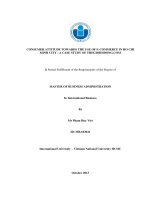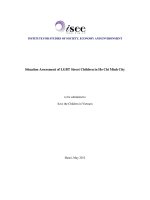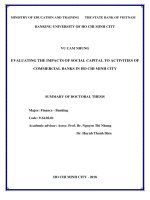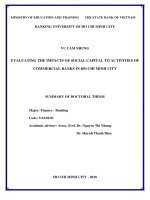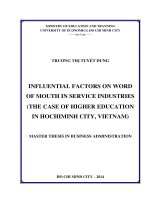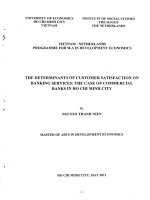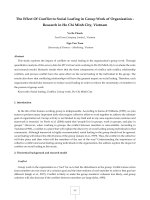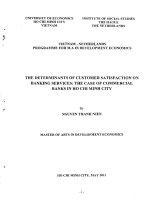The risk of getting infected with hiv aids of street children in ho chi minh city problems and solutions
Bạn đang xem bản rút gọn của tài liệu. Xem và tải ngay bản đầy đủ của tài liệu tại đây (19.71 MB, 56 trang )
HO CHI MINH CITY UNIVERSITY OF FOREIGN LANGUAGES - INFORMATION TECHNOLOGY
DEPARTMENT OF INTERNATIONAL RELATIONS - ENGLISH
GRADUATION PAPER
•
THE RISK OF GETTING INFECTED
WITH HIV/ AIDS OF STREET
CHILDREN IN HO CHI MINH CITY PROBLEMS AND SOLUTIONS
by PH~M NGUYEN QUYNH ANH
advised by NGUYEN THAI MQNG TUYEN, MA.
September, 2008
ACKNOWLEDGEMENTS
First of all, I would like to express my deepest gratitude to my family that has
given me spiritual and financial support for my life- orientation to get a bright future.
This is a great opportunity to express my respect to the Board of Director of
Department of International Relations - English for creating good conditions to do this
paper.
In addition, I would like to thank greatly my dean, Vu Quoc Anh, MA., for his
instruction and support during the time doing this paper.
Especially, I would like to send my deep indebtedness and sincere thanks to
Nguyen Thai Mong Tuyen, MA., my adviser, for her early and continuous wholehearted assistance and corrections to complete this thesis.
Next, I wish to express my thanks to Vu Ngoc Son, MD., PhD., for with me
sincere advice and valuable data concerning my field of study. Without these materials,
my research would have been incomplete.
Moreover, I am pleased to thank Mr. Tran Minh Tan working for the World
Vision Organization for helping me contact the places that I did the questionnaire.
I am also equally grateful to my brother, Mr. Chu Quoc Dung, who also works for
the World Vision Organization, for his experience in working with street children and
inspired me during the time I did this research.
Besides, my research would not have been so successful if I had not received the
help from Thieu Nien 3 School, Thao Dan, Cay Mai Group, Tre Xanh Warm House,
Cau Han Project and 70 respondents who participated in the questionnaire serving this
study.
Finally, I would like to thank my friends for their encouragement and help to me
in carry out this research.
ABSTRACT
Ho Chi Minh City is the most crowded and developing city in Viet Nam.
However, besides its prosperity, there are some social problems needed to be solved,
and one of them is street children. They do not have enough conditions to develop with
good care and education because of different reasons. For instance, some children come
from broken families, others try to support their family's income, or some others
become street children because of peer pressure. Thus, they are easy to be involved in
social evils and epidemics, especially, street children in Vietnam in general and in Ho
Chi Minh
in particular
are now
facing
HIV/AIDS.
Although
the preventive,
communicative, and treatable measures are being continued, the risk of getting infected
with HIV/AIDS is still high. A questionnaire was carried out with [10 children, who
seemed to understand about HIV/AIDS but not deeply. Therefore, the paper is done
with the writer's hope of finding the knowledge of street children in Ho Chi Minh City
about
HIV/AIDS.
From that,
giving the comments
on present
situations
and
recommending some suggested solutions to help them understand this epidemic more
clearly and know how to protect themselves effectively .
•
11
TABLE OF CONTENTS
Pages
ACKN 0 WLEDG EMENTS
i
ii
AB STRA CT
Chapter
1: INTRODUCTION
01
1.1. Background
01
1.2. The urgency of doing this research
02
1.3. The aims of the study
03
1.4. The organization of the paper..
04
1.5. Limitations of the research
04
Chapter 2: LITERATURE
REVIEW
05
2.1. Street children with HIY/AIDS
05
2.1.1. Who are street children?
05
2.1.2. The overview of HIV /AIDS
06
2.1.3. The risk of getting infected with HIV/ AIDS of street children
08
2.2. Some materials related to the issue
Cha pter 3: METHODO LOGY
09
12
3.1. Subjects
12
3.2. Materials
12
3.3. Procedures
13
3.4. Statistical treatment
14
Chapter 4: FINDINGS AND DISCUSSION
15
4 .1. Overview
15
4.2. A brief review of personal information of street children
15
4.3. Results of the questionnaire
19
4.3.1. Questions 1, 2 and 3
19
HI
4.3.2. Questions 4 and 5
21
a. Question 4
21
b. Question 5
22
4.3.3. Questions 6 and 7
24
a. Question 6
24
b. Question 7
26
4.3.4. Question 8
27
4.3.5. Question 9
28
4.3 .6. Questi on 10
30
4.4. Some suggestions for helping street children learn about HIV/AIDS ...32
Cha pter 5: CON CL U SI 0 N
34
APPEND IX 1
35
APPE ND IX 2
40
RE FERE N CE LIST
46
iv
LIST OF TABLES AND FIGURES
Page
•
1. Figure 4.1. Gender of the street children
16
2. Table 4.2. Age of the street children
16
3. Figure 4.3. The ages of the street children
17
4. Figure 4.4. Family status
17
5. Figure 4.5. Results of question 2
19
6. Figure 4.6. Results of question 3
20
7. Figure 4.7. Results of question 4
21
8. Table 4.8. Results of question 5 (a)
22
9 . Figure 4.9. Results of question 5 (b)
23
10. Figure 4.10. Results of question 6a
24
11. Figure 4.11. Results of question 6c
25
12. Figure 4.12. Results of question 7
26
13. Figure 4.13. Results of question 8b
27
14. Figure 4.14. Results of question 9b
28
15. Figure 4.15. Results of question 9c
29
16. Figure 4.16. Results of question 10
30
v
I
ADVISER'S ASSESSMENTS
.
vi
EXAMINER'S ASSESSMENTS
•
"
vii
Chapter 1: INTRODUCTION
1.1. Background
Nowadays,
Vietnam is more and more developed to integrate into the
international market. In addition, our country has become a member of WTO for
one year, which creates more chances for us in the international arena. However,
some specialists of an American Bank of Investment predicted that the GDP
growth has been about 7.3% and 7.8% in this year and the next year compared
with 8.5% in the last year. The inflation was up to 21.4% in April, 2008 (as only
8.6% in August, 2007).
1
These figures reflect a crisis in the balance payment of
our country. Actually, the life - standard is improved day by day, but the money
is devalued which makes the poor's lives difficult. Moreover, there are still social
problems such as homeless people, beggars, gambling, drug abuse, etc which
need to be solved, and one of them is street children. They are wandering on the
streets to earn their living, and social evils are very close to them. As a number of
children infected with and affected by HIV/AIDS increases, so does the need to
have an in-depth understanding of the impact of HIV/AIDS on them. For this
reason, the problem which I will deal with is the risk of getting infected with
HIV /AIDS of street children in Ho Chi Minh City.
Street children in Vietnam appeared at the end of 1980s. At that time, it was said that
they are "dust of life"; it means that they were wandering, sleeping and working on
streets. Most of them fell into bad situation after leaving their homes. They had to live
in cities where they had a danger to be enticed to being prostitution. using or selling
drugs, and being baits of exploitation. [oo.J This number of street children is increasing
in Vietnam (Acoleyen, 1999)?
I
kinhdoanhI180552/index.htm retrieved May 29, 2008.
2
Page 4, Graduation paper ofLe Thi Van, Course 8 (1999-2003) - Sociology department of Open
University.
Children end up on streets for different reasons. For instance, some of them
escape from broken families or domestic quarrels. For others, their parents'
poverty leads them to supply family income in the street - living. In addition, the
breakdown
of traditional
family values, education, sense of humanity. and
community structure leave a large number of children without necessary care and
support in their growth. Street children are not mature enough to understand the
social life, so they have become victims of social evils. They are involved in drug
abuse, illegal alcohol issues and sexual relations, etc. These things often happen
in urban life, especially in big cities, Ha Noi and Ho Chi Minh.
According to the statistics of the Ministry of Health (2006), there were
8.500 HIV- infected children in Vietnam, most of them were street children.
However, at present, this figure has not totaled up completely yet. In Ho Chi
•
Minh City, there are 10.000 children in danger of HIV/AIDS because of their
unsafe lives3. We can acknowledge that HIV/AIDS epidemic is attacking people,
especially children in general and street children in particular.
1.2. The urgency of doing this research
At present, the newest report of Ministry of Health shows that the total of
HIV- infected people who have died in our country is up to 39.180; and the
number of HIV- infected people who are still alive is 127.442 cases. This
epidemic has spread national wide with an average infection ratio 28.6%; and
Quang Ninh is the top rank with 54.5%; the second rank is Ho Chi Minh City
47.6%; Hai Phong 46.25%; Can Tho 45%; Thai Nguyen 40.75%; and the last one
is Dien Bien 36.83%.4
3
/>
4
/>
165 retrieved January 9, 2008
retrieved June 9, 2008
2
Moreover, in Tuoi Ire vi tuoi tre page,
/>December
(accessed
19, 2007) an article entitled "HIV/AIDS epidemic attacking street
children" was posted. Mentioning about street children, people are often worried
about juvenile delinquencies, infected diseases from street - living, etc. Now,
HIV epidemic along with drugs and sexual harassment are the pressing problems
that we need to overcome as soon as possible.
From the two elements above, we can see that those figures give us an alarm
about HIV/AIDS problem and this epidemic concentrates in the overpopulated
cities. Furthermore, this problem has made bad effects on many fields of social
life and also on economic growth of our country in general and of Ho Chi Minh
City in particular. Thus, I hope to have a part in helping street children's
awareness of HIV/AIDS, thence they know how to prevent themselves from this
epidemic.
1.3. The aims of the study
There have been many studies and reports on the issue of street children
with different purposes and methods. "Interactions of Old and New Causes in a
Growing Economy compared the differences between Ho Chi Minh and Ha Noi"
written by Duong Kim Hong (2005) is an example.
Recently, there was a writing named "Formative Research on HIV/AIDS
vulnerability
among Street Youth in Ho Chi Minh City" conducted by the
Quality of Life Promotion Centre (June, 2007). Basing on information I collected
and the present situations, an analysis of the risk of getting infected with
HIV/AIDS of street children in Ho Chi Minh City will be done. The purpose of
this paper is also to find out the understanding of street children about HIV/AIDS
3
by a practical survey. From the feedback getting from street children, some
comments and recommendations, as well as suggested solutions are given to help
street children understand about HIV/AIDS more clearly and know how to
protect themselves effectively.
1.4. The organization of the paper
This paper consists of five main parts. The first part introduces the overview
of street children and the urgency of doing the research. It then goes on to a
review of the existing studies which the topic is concerned with and definitions
of the terms main of the topic, for example, street children, HIV/AIDS, etc. In
short, these things belong to the second part named literature review. Next, that is
the methodology presenting the ways that I carry out the research. After doing a
questionnaire, the fourth part, findings and discussion, is stated. Finally, the
suggestions and conclusion are presented in the last part.
1.5. Limitations of the research
Firstly, it was difficult to identifY the street children at the age of 13 to 18
years old in the parks, so I couldn't do the survey because they were older or
younger than my subjects. Besides, when I met some street children at Cay Mai
Group, all of them did the questionnaire. However, some of them were older than
my subjects, so I had to eliminate their answers. Next, the data collection was
undertaken in the summer, the street children in some centers didn't go to school,
so they went to work out all day, and it was not easy to meet them. Moreover, the
time was restricted.
Therefore, the scope of my study was limited to 70
respondents whereas the questionnaire was intended for 100 street children at
first.
4
Chapter 2: LITERATURE REVIEW
2.1. Street children with HIV/AIDS
2.1.1. Who are street children?
The term of street children or children wandering and earning on the street
being used by some Vietnam government officials are the same. However,
according to Wikipedia, "street children, street kids are homeless children who
live on the street - in particular, those that are not taken care of by parents or
other adults. Street children live in abandoned buildings, containers, automobiles,
parks, or on the street itself'.
•
The UNICEF definition and categorization said "street children are defined
as children under 18 years old who spend most of their time on the street". There
are 3 types:
1. Street-living: Those who cut ties with their fainily and live alone on the
streets.
2. Street-working:
Those who spend all their time or most of their time
working on streets to provide income for their families or for themselves. These
children have a home to return to and do not usually sleep on the streets.
3. Street-family: Those who live with their families on the streets.
In general, street children are not a homogeneous group. Each child has a
different family background, a different reason for being on the street, and some
different
needs to be fulfilled.
After the categorization,
we will clearly
understand the problems and the needs of each group.
5
2.1.2. The overview ofHIV/AIDS
,-
People have been warned about HIV/ AIDS for over twenty years at
present. Although the preventive, communicative,
and treatable measures are
being continued, the risk of infected with HIV /AIDS is still high. Therefore,
HIV /AIDS is becoming one of the biggest problems facing the world today and
nobody is beyond its reach. In this section, we will find out the basic facts about
HIV/AIDS.
According
to
an
/>
international
retrieved
AIDS
June
13,
charity,
2008,
Avert,
HIV
at
(Human
Immunodeficiency Virus) is a virus. The virus infects the cells that make up the
human body and replicates (makes a new copy of itself) within those cells. This
virus can also damage human cells, which is one of the things that can make a
person ill.
HIV can be passed from one person to another. There are three main HIV
transmissions:
having sexual relations with HIV- infected people; using same
injection needles, receiving blood from infected people; being passed from a
HIV- infected mother to her child during pregnancy, delivery and breast-feeding.
On the other hand, there are several potential modes of HIV transmission to
children, including mother - to - child transmission, sexual transmission among
adolescents, sexual abuse of children, transfusion of infected blood or blood
products, unsterile injection procedures, and scarification.
AIDS (or Acquired Immunodeficiency
Syndrome) is the result of the
infection with the HIV virus, and also the result of other "opportunistic"
6
infections which invade the body as a result of its diminished capacity for
resistance.
There is currently no cure for HIV/AIDS, although there are medications
which can prolong the period of a "normal" healthy life. At present, antiretroviral
therapy (ART) for HIV- infected people is considered as one of the most positive
measures, and the goals of treatment with antiretroviral (ARV) drugs are to:
•
Prolong the survival of HIV- infected patients
•
Promote optimal growth and development
•
Reduce opportunistic infections
•
Prevent disease progression
According to Associate professor - PhD. Nguyen Duc Hien, Director of the
National Institute for Clinical Research & Tropical Medicine, reported that HIVinfected children are primary subjects in treatment with ARV, which helps
reduce the morbidity of children and improve their quality of life with its effects:
suppress HIV replication and preserve, enhance, or reconstitute the immune
system. Nevertheless, the treatment of HIV-infected children with ARV drugs
depends on available local resources and infrastructure.
ARV drugs are expensive; and their use requires knowledgeable healthcare
workers because it is a rapidly changing field, and it has benefits to child health.
On the other hand, ART does have limitations, for example, patients on ART
may develop adverse drug actions; drug interaction and drug resistance may
decrease the potency of ARV drugs, etc; so HIV- infected people need to be
tested before using this medicine at the right time.
7
2.1.3. The risk of getting infected with HIV /AIDS of street children
There
are many problems
which
make street
children easy to get infected with HIV/AIDS.
example,
they
are lacking
of understanding
For
about
HIV/AIDS, living in an unsafe environment or earning
their money, etc.
Today,
foundations
there
are
many
and non-governmental
supported
organizations
social
that
are raising disadvantaged children. However, there are still many children on the
streets who are like lonely birds in a human tide. They are homeless people, so
street- living is familiar to them. They don't know the traps of life are right
beside them. In daily activities, street children contact many kinds of people, bad
and good. Yet, I want to talk about the bad people. They take advantage of
children's naivety for their "purposes". For example, they give street children an
children are familiar with their work,
and they try using drugs in someday.
Moreover, some children often use the
same injection needles when they take
drugs. From that, it is easy for them to
get infected with HIV/AIDS.
Some children are enticed to be a streetwalker with foreigners or local
people, after that they have unsafe sex. Sometimes, the children request their
partners using condoms, but they don't agree because they don't feel pleasure
while wearing them, especially foreigners. Thus, the children dare not to refuse
because they are in need of money. On the other hand, some children think that
they don't need preventive measures when they have sexual relations with their
8
girlfriends or boyfriends.5 Other children think that HIV/AIDS
IS
a disease of
adults, and it easy to cure.
In short, the knowledge about HIV/AIDS of street children is restricted.
Therefore, street children are in danger of getting infected with HIV /AIDS
epidemic anytime and anywhere. What can we do for them?
2.2. Some materials related to the issue
"Street children" is one of the most pressing social problems in Vietnam in
general and in Ho Chi Minh City in particular. In addition, HIV/AIDS epidemic
is attacking men, especially children, a young generation for the development of
a country. In this research, I hope to reveal a problem, street children facing with
HIV /AIDS in Ho Chi Minh City.
In the past years, there have been some studies and articles on street
children in Vietnam. The first one is Interactions of Old and New Causes in a
Growing Economy compared the differences between Ho Chi Minh and Ha Noi
written by Duong Kim Hong and Kenichi Ohno (July, 2005).
People sometimes call them roaming kids or "dust of life." However, the dynamic
mechanism that prompts these children to drop out of school and go selling in the street
is yet to be analyzed deeply or comprehensively.
parents'
Such causes as dire poverty and
divorce may be common to the street children problem in all developing
countries, but other causes may be unique to Hanoi and Ho Chi Minh, the two cities
experiencing an enormous social and economic transformation.
This research gave three causes of street children such as broken family, mindset
problem and economic migration. In addition, the situation in their writing was
divided into present protection and future investment. They showed that all street
children were not a homogeneous
group, so the authorities
should have
appropriate solutions for the needs of each group.
5
iVietnam/Doi-soneJ2006/07/3B9EC165/ retrieved January 9, 2008
9
The second writing is that Jan W de Lind van Wijngaarden,
UNICEF
consultant, (April 22, 2006) with Literature Review: Exploring factors
processes
leading to HIV risk among the most vulnerable
and
children and
adolescents in Vietnam.
Both Bond and Forsyth note that the vulnerability of some categories of street children
to HIV/AIDS have increased in recent years; this is mainly due to their growing habit of
drug abuse, but also because a perceived growth in the number of street children
involved in sex work. It is well known that street children have a higher risk to be
sexually or otherwise exploited; being dependent on drugs increases the chance of
sexual exploitation, since sex work is one of the few ways for children to make money.
Tim Bond found surprisingly little sex work among the street children he studied in Ho
Chi Minh City; most of them made a living by begging, scavenging and petty theft.
Besides, this writing stated gaps in our knowledge about HIV vulnerability
among children and adolescents, and it was also concerning with ongoing and
planned research on HIV vulnerability
among children and adolescents
in
Vietnam.
Next, Odu 00, Asekun-Olarinmoye
Contracept
Reprod
Health
EO, Bamidele JO, et al. Eur J
Care 2008; 13(1):90-6, Knowledge,
attitudes
to
HIV/AIDS and sexual behavior of students in a tertiary institution in southwestern Nigeria, the authors carried out a. descriptive cross-sectional
survey
between January and March 2005. They got information from 368 students in
Ede, Osun State, Nigeria. Participants were selected by a multi-stage sampling
method and data obtained using a semi-structured pre-tested questionnaire.
Most (89.4%) respondents were aware of the existence of HIV/AIDS, and knew the
etiology, routes of transmission, signs and symptoms, and preventive measures against
the disease. While a little over half (59.8%) of the respondents revealed that they could
hug people with HIV/AIDS, one out of four (27.2%) stated that these persons should be
isolated from the community. Less than a quarter (22.3%) of the respondents believed
that they were vulnerable to HIV/AIDS. The study revealed a gap in the knowledge of
HIV/AIDS and an inappropriate sexual behavior among respondents.
10
Formative Research on HIV/AIDS vulnerability among Street Youth in Ho
Chi Minh City was conducted by the Quality of Life Promotion Centre (June,
2007). The aim of this research was to identitY possible risks and protective
factors of HIV/AIDS prevention among four different sub-groups of street
children
and youth
recommendations
(SCY)
from
15 to 24 years
in order
to develop
for appropriate and effective responses. They said that SCY's
knowledge ofHIV/AIDS was limited and often misinformed. Aside from naming
the three main transmission routes of HIV, SCY were not aware of other possible
routes of HIV transmission as well as prevention methods. The few respondents
who had received HIV communication were more accurate. In this study, they
found out various risk factors and gaps in SCY knowledge and attitudes towards
HIV/AIDS prevention.
Moreover, according to Cong An Nhan Dan Newspaper (Monday, March
19,2007) having an article called "Street children in danger ofHIV/AIDS"
with
the header in bold: "A shoe polishing boy told about his itinerary on streets
spontaneously. He told the times begging, polishing shoe, selling candies, etc ...
even sometimes elder brothers entangled him in "injection", and "confide" in
elder women." Children, at the age of them, only know to study and eat instead
of striving to make their living. They are so young in society, but they have to
earn their living. With immature understanding, they think that the big cities are
the places where they can earn money; they don't know that many risks are
always beside them.
In summary, each research has a different way to analyze the street children
and their risks in the daily life. One thing needs to be emphasized that the
knowledge about HIV /AIDS of a young generation in general and street children
in particular has not been widely communicated. With these reference materials
and others from the Internet, as well as doing the questionnaire, the paper "The
risk of getting infected with HIV/AIDS of street children in Ho Chi Minh City Problems and Solutions" is hope to be finished successfully.
11
Chapter 3: METHODOLOGY
3.1. Subjects
The subjects of my research were 13 to 18 year- old street children
wandering on streets or living at warm houses, and street children centers.
According to EriksonlUNICEF,
at the age of 13 - 18, the children are in
adolescence. Their physical bodies develop quickly, and they get interest in same
or different sex. They know who they are obviously, but they are so sensitive
how people recognize them. At this time, friends play an important role than their
parents. Moreover, some of the parents feel difficult in raising their children
because they want to be independent. Especially, the juveniles get rebellious at
this time when they experience pains, difficulties, shames, and so on in their
childhood. On the other hand, the adolescents feel mature and confident if they
get love and care from people. At the adolescence,
they often built Iife-
orientation through the direction of adults. Therefore, street children at this age
were chosen as subjects in my study.
Furthermore, the number of street children taking part in this research was 70
children who represent for street children in Ho Chi Minh City. Places gathering
street children were located throughout Ho Chi Minh City, but I went to five of
them.
3.2. Materials
There was one questionnaire
carried out to serve the research. The
questionnaire consisting of 10 multiple - choice questions were done to find out
the understanding of street children about HIV/AIDS. They are two questions
about what HIV is and what AIDS is; the modes of HIV transmission and nontransmission; the attitude of street children towards HIV - infected people; one
question how to prevent from getting infected with HIV. In addition, there were
12
two situations asking about the street children's attitude towards drug and sexual
relations. The last question gave some ways for street children to learn about
HIV/AIDS and avoiding the disease effectively. Especially, the questionnaire
was written in Vietnamese in the survey; then it was translated into English and
attached to this paper.
Besides, the information relating to this problem was collected from articles
on the Internet and printed writings which helped to understand real situations
deeply in comparison with the results from the questionnaire.
3.3. Procedures
First of all, the questionnaire was designed and delivered to the street
children of the
Ii~ places:
Thieu Nien 3 School (Go Yap district), Thao Dan
(district 3), Tre Xanh Warm House (district 1), Cay Mai Group (Cho Lon, district
5), and Cau Han Project (district 7). In general, street children in centers are now
many younger than older ones (under 13 years old); and street children in the
parks are difficult to gather if we have no help from street educators. Most of
street children could do the questionnaire by themselves; some of them were
interviewed because they were illiterate. After the questionnaire sheets were
filled, they were returned to the researcher.
Secondly, basing on the results from the questionnaire, a speci fie analysis of
the number
of street children
understanding
and misunderstanding
about
HIV/AIDS was carried out. From that, some comments on the real situation of
street children towards HIV/AIDS
problem were given. In addition, some
solutions to how to help street children learn about and avoid it effectively were
suggested. It is the writer's wish to contribute to fill in the gaps in the knowledge
ofHIV/AIDS
among street children, and to help them be confident in their lives .
•
13
3.4. Statistical treatment
To find out the knowledge of street children about HlV/AIDS, a data processing was done based on the answers to the questionnaire. A data capture
from the questionnaire was transcribed and coded in Excel by the researcher.
Moreover, these figures were illustrated by charts for readers to understand
easily. The data was valuable if the results of the questionnaire were reliable and
honest. From that point, the statistics reflected how street children understood
HlV /AIDS epidemic.
14
Chapter 4: FINDINGS AND DISCUSSION
This chapter aims to give the results received from the questionnaire, and
then an analysis of these results is presented to reach a conclusion of this
research.
4.1. Overview
A questionnaire was delivered to the subjects in five places, and at the time
required, there were 70 completed questionnaires returned. They were 30 sheets
from Thieu Nien 3 School, 8 sheets from Thao Dan; Tre Xanh Warm House with
6 sheets, Cay Mai Group with 12 sheets, and 14 ones from Cau Han Project.
In the first part of the questionnaire, the questionnaire were asked about
their personal information such as age, gender, education, place to live, family
status, and native place. However, there were 10 answers from those at the older
ages than my subjects, so their answers were not counted.
In the second part, there were 10 multiple- choice questions which tried to
find out the understanding ofHIV/AIDS of street children.
4.2. A brief review of personal information of street children
First of all, among 70 respondents, there were 44 males (66%), 26 females
(34%), and 0 undefined (0%) which showed that street boys were more than
street girls. These figures were illustrated by a pie chart below. (Figure 4.1)
15
o Male
II Female
Figure 4.1. Gender of the street children
Age
13
14
15
16
17
18
Quantity/people
9
11
19
10
13
8
Table 4.2. Age of the street children
Next, the results in table 4.2 told us that the ages of the subjects were from
13 to 18 years old. It can be concluded, that there was not much difference in
ages of street children in this survey. (Figure 4.3)
One more thing is a brief review of education of the subjects. There were 11
children who were studying in the second grades at the age of 13, 14, 15, and 17;
and it meant that they did not have chances and conditions to go to school in
accordance with their ages. Moreover, 42 children were studying from the fifth to
the eleventh grades, and they made up two thirds of the total. Besides, the
number of street children finished school only was 7 people whereas there were
still 10 children who didn't go to school. Overall, most of children had an
opportunity to be educated, although some children did have no conditions to go
to school.
16
20
=a.
l.
-.-='e
15
C"l
••••0 10
l.
a.
.c
5
==
a.
-=~
5
0
13
14
15
16
17
18
The ages
Figure 4.3. The ages of the street children
Finally, the family status, a basic foundation, was so important to children,
but there were still some problems.
o Alive
• Died
I!!I
Father
Unknown
Mother
Figure 4.4. Family status
17

